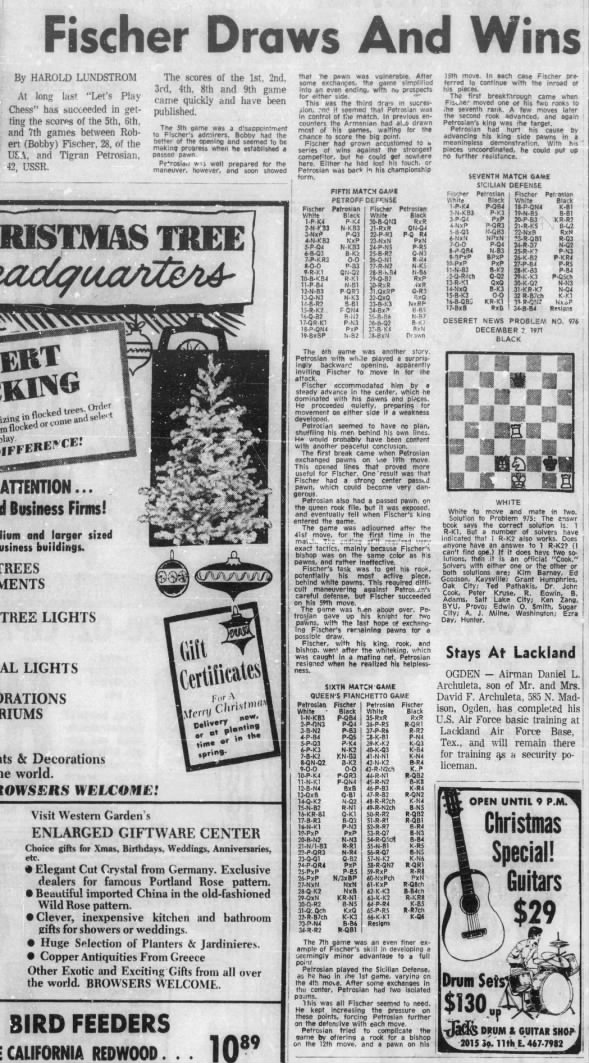< Prev Index Next >
 Chess Fri, Dec 3, 1971 – 16 · Deseret News (Salt Lake City, Utah) · Newspapers.com
Chess Fri, Dec 3, 1971 – 16 · Deseret News (Salt Lake City, Utah) · Newspapers.com
Let's Play Chess by Harold Lundstrom Friday, December 03, 1971 Deseret News Salt Lake City, Utah Deseret News Problem...
Posted by Bobby Fischer's True History on Wednesday, November 25, 2020
Deseret News Problem No. 976. White to move and mate in two.
FEN 8/4q3/8/8/4R3/8/3QN1k1/4K2R w - - 0 1
Key: N-B4/Nf4+
Let's Play Chess: Fischer Draws And Wins by Harold Lundstrom
At long last “Let's Play Chess” has succeeded in getting the scores of the 5th, 6th, and 7th games between Robert (Bobby) Fischer, 28, of the USA and Tigran Petrosian, 42, USSR.
The scores of the 1st, 2nd, 3rd, 4th, 8th and 9th game came quickly and have been published.
The 5th game was a disappointment to Fischer's admirers. Bobby had the better of the opening and seemed to be making progress when he established a passed pawn.
Petrosian was well prepared for the maneuver, however, and soon showed that the pawn was vulnerable. After some exchanges, the game simplified into an even ending, with no prospects for either side.
This was the third draw in succession, and it seemed that Petrosian was in control of the match. In previous encounters the Armenian had also drawn most of his games, waiting for the chance to score the big point.
Fischer had grown accustomed to a series of wins against the strongest competitor, but he could get nowhere here. Either he had lost his touch, or Petrosian was back in his championship form.
The 6th game was another story. Petrosian with white played a surprising backward opening, apparently inviting Fischer to move in for the attack.
Fischer accommodated him by a steady advance in the center, which he dominated with his pawns and pieces.
He proceeded quietly, preparing for movement on either side if a weakness developed.
Petrosian seemed to have no plan, shuffling his men behind his own lines. He would probably have been content with another peaceful conclusion.
The first break came when Petrosian exchanged pawns on the 19th move. This opened lines that proved more useful for Fischer. One result was that Fischer had a strong center passed pawn, which could become very dangerous.
Petrosian also had a passed pawn, on the queen rook file, but it was exposed, and eventually fell when Fischer's king entered the game.
The game was adjourned after the 41st move, for the first time in the match. The ending still required very exact tactics, mainly because Fischer's bishop was on the same color as his pawns, and rather ineffective.
Fischer's task was to get his rook, potentially his most active piece, behind white pawns. This required difficult maneuvering against Petrosian's careful defense, but Fischer succeeded on his 59th move.
The game was then about over. Petrosian gave up his knight for two pawns, with the last hope of exchanging Fischer's remaining pawns for a possible draw.
Fischer, with his king, rook, and bishop, went after the white king, which was caught in a mating net. Petrosian resigned when he realized his helplessness.
The 7th game was an even finer example of Fischer's skill in developing a seemingly minor advantage to a full point.
Petrosian played the Sicilian Defense, as he had in the 1st game, varying on the 4th move. After some exchanges in the center, Petrosian had two isolated pawns.
This was all Fischer seemed to need. He kept increasing the pressure on these points, forcing Petrosian further on the defensive with each move.
Petrosian tried to complicate the game by offering a rook for a bishop on the 12th move, and a pawn on his 15th move. In each case Fischer preferred to continue with the inroad of his pieces.
The first breakthrough came when Fischer moved one of his two rooks to the seventh rank. A few moves later the second rook advanced, and again Petrosian's king was the target.
Petrosian had hurt his cause by advancing his king side pawns in a meaningless demonstration. With his pieces uncoordinated, he could put up no further resistance.






















